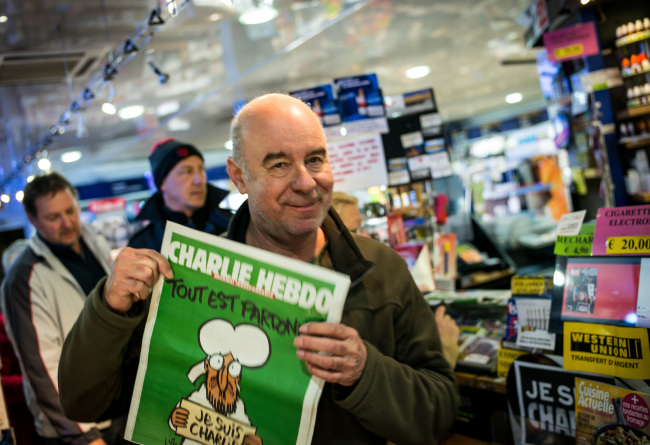By claiming responsibility for the attack on a French satirical magazine, al-Qaida showed it’s still a potent threat as the U.S. and Europe focus on fighting what they consider the bigger menace of Islamic State.
The Yemen-based al-Qaida in the Arabian Peninsula, which has planted bombs in underwear, body cavities and parcels, slipped from international attention in the past few years as it focused on confronting local enemies. Last week’s attack at the offices of Charlie Hebdo in Paris, the group’s first operation in Europe, was a reminder it never went away.
“Al-Qaida in the Arabian Peninsula have always been a problem to be dealt with,” said Michael Stephens, research fellow for Middle East Studies at the Royal United Services Institute, or RUSI, in London. “This is just a realization of the threat that has existed for years.”

Customers line up to buy copies of Charlie Hebdo in the provincial town of Aucamville, near Toulouse, France, Wednesday. (UPI-Yonhap)
Wednesday’s claim came in a video message posted on social media that U.S. intelligence services said appeared to be authentic. In it, one of the group’s top leaders, Nasr bin Ali Alanesi, said the Jan. 7 Paris assault was in response to the cartoons the magazine published depicting the Prophet Muhammad and punishment for French engagement in Muslim countries.
“This is a new turning point in the history of confrontation,” Alanesi said. He urged Islamic youth to “be generous with your lives” in support of the prophet and to avenge the death of Muslims.
The events in Paris reflect some of the competition that’s developed between al-Qaida and Islamic State, said Ayham Kamel, Middle East and North Africa director at Eurasia Group.
The rampage at the magazine was committed by brothers Cherif and Said Kouachi, French citizens of Algerian descent. In a phone interview with BFM TV before the police raid in which he died, Cherif Kouachi said he and his brother were carrying out the attack on behalf of deceased cleric Anwar al-Awlaki, whom he claimed to have met while training with al-Qaida in Yemen.
In separate deadly incidents as the officers sought and then closed in on the brothers, Amedy Coulibaly killed a policewoman and then took hostages in a kosher grocery a day later. He killed four of his captives before he was shot dead.
A video published later showed Coulibaly justifying the attacks on behalf of Islamic State. In the al-Qaida message, Alanesi said the Charlie Hebdo operation “coincided” with the attacks by Coulibaly.
The extremist groups are jostling for “who is the true legitimate source and inspiration for a more conservative and purest form of political Islam,” said Kamel. “Both are competing for influence and ideology in thought and in financing. That has created echoes beyond the Middle East.”
After taking control of territory in Syria and Iraq over the past year, U.S.-led coalition forces have been targeting airstrikes against Islamic State.
While there may be competition at the top, the relationship between the group and al-Qaida on the ground is more nuanced, said Magnus Ranstorp, research director at the Swedish National Defence College in Stockholm. Islamic State and al-Qaida-affiliated Nusra Front are fighting each other in Syria.
“The local level on the ground is more complex,” Ranstorp said. “Often they kill each other, in some areas they cooperate, maybe a little bit on the local level.”
Al-Qaida in the Arabian Peninsula was formed in 2009 when the terror group’s Yemeni and Saudi branches merged following a crackdown by Saudi Arabia that drove its militants to the kingdom’s impoverished and lawless neighbor.
The group remains a threat, yet its potential impact pales into insignificance compared with the bigger risk from Islamic State, said Stephens at RUSI.
“They do have a bit of funding available, they are able to radicalize people,” said Stephens. “It’s just not the same thing as tens of thousands of people moving from Western countries and from the Gulf to go and serve a caliphate with a structure and an army and missiles.”
In Yemen, the Sunni Muslim militants of al-Qaida and their tribal allies are engaged in an escalating conflict with Shiite fighters who seized much of the capital Sana’a last year.
The Paris attack was a departure from the al-Qaida group’s focus on the aviation industry and bomb making.
On Christmas Day 2009, Umar Farouk Abdulmutallab, a Nigerian who had trained with the group, attempted to blow up a Northwest Airlines plane over Detroit with explosives hidden in his underwear. He was arrested after the bomb malfunctioned.
A few months earlier, the group attempted to assassinate Saudi Prince Muhammad bin Nayef, who then headed counterterrorism efforts, by implanting a device inside a suicide bomber’s body cavity. He survived and is now Saudi Arabia’s interior minister.
The last major attempted attacks linked to the group were in October 2010, when packages containing explosives were intercepted and defused in Dubai and the U.K. They were being shipped from Yemen to synagogues in Chicago. (Bloomberg)






